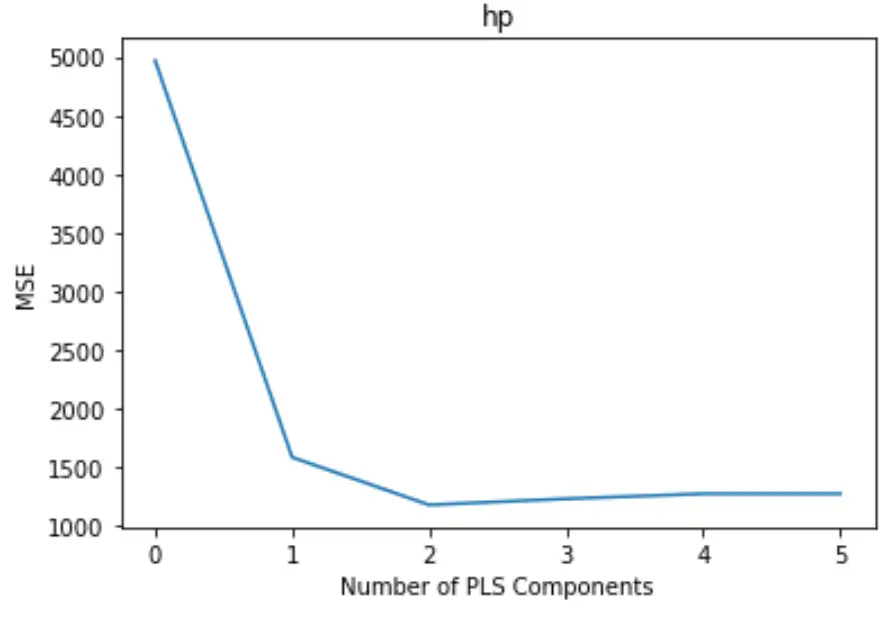Python 中的偏最小二乘法(一步一步)
机器学习中最常见的问题之一是多重共线性。当数据集中的两个或多个预测变量高度相关时,就会发生这种情况。
发生这种情况时,模型可能能够很好地拟合训练数据集,但它可能在从未见过的新数据集上表现不佳,因为它与训练数据集过度拟合。训练集。
解决这个问题的一种方法是使用一种称为 偏最小二乘法的方法,其工作原理如下:
- 标准化预测变量和响应变量。
- 计算p 个原始预测变量的M 个线性组合(称为“PLS 分量”),这些组合解释了响应变量和预测变量中的大量变化。
- 使用最小二乘法拟合线性回归模型,并使用 PLS 分量作为预测变量。
- 使用k 折交叉验证来找到模型中保留的 PLS 组件的最佳数量。
本教程提供了如何在 Python 中执行偏最小二乘法的分步示例。
第1步:导入必要的包
首先,我们将导入在 Python 中执行偏最小二乘法所需的包:
import numpy as np
import pandas as pd
import matplotlib. pyplot as plt
from sklearn. preprocessing import scale
from sklearn import model_selection
from sklearn. model_selection import RepeatedKFold
from sklearn. model_selection import train_test_split
from sklearn. cross_decomposition import PLSRegression
from sklearn . metrics import mean_squared_error
第2步:加载数据
在此示例中,我们将使用名为mtcars的数据集,其中包含 33 辆不同汽车的信息。我们将使用hp作为响应变量,并使用以下变量作为预测变量:
- 英里/加仑
- 展示
- 拉屎
- 重量
- 快秒
以下代码展示了如何加载和显示此数据集:
#define URL where data is located
url = "https://raw.githubusercontent.com/Statorials/Python-Guides/main/mtcars.csv"
#read in data
data_full = pd. read_csv (url)
#select subset of data
data = data_full[["mpg", "disp", "drat", "wt", "qsec", "hp"]]
#view first six rows of data
data[0:6]
mpg disp drat wt qsec hp
0 21.0 160.0 3.90 2.620 16.46 110
1 21.0 160.0 3.90 2.875 17.02 110
2 22.8 108.0 3.85 2.320 18.61 93
3 21.4 258.0 3.08 3.215 19.44 110
4 18.7 360.0 3.15 3.440 17.02 175
5 18.1 225.0 2.76 3.460 20.22 105
步骤 3:拟合偏最小二乘模型
以下代码显示了如何使 PLS 模型适合此数据。
请注意, cv = RepeatedKFold()告诉 Python 使用k 折交叉验证来评估模型性能。对于本例,我们选择 k = 10 次,重复 3 次。
#define predictor and response variables
X = data[["mpg", "disp", "drat", "wt", "qsec"]]
y = data[["hp"]]
#define cross-validation method
cv = RepeatedKFold(n_splits= 10 , n_repeats= 3 , random_state= 1 )
mse = []
n = len (X)
# Calculate MSE with only the intercept
score = -1*model_selection. cross_val_score (PLSRegression(n_components=1),
n.p. ones ((n,1)), y, cv=cv, scoring=' neg_mean_squared_error '). mean ()
mse. append (score)
# Calculate MSE using cross-validation, adding one component at a time
for i in np. arange (1, 6):
pls = PLSRegression(n_components=i)
score = -1*model_selection. cross_val_score (pls, scale(X), y, cv=cv,
scoring=' neg_mean_squared_error '). mean ()
mse. append (score)
#plot test MSE vs. number of components
plt. plot (mse)
plt. xlabel (' Number of PLS Components ')
plt. ylabel (' MSE ')
plt. title (' hp ')
该图沿 x 轴显示 PLS 分量的数量,沿 y 轴显示 MSE(均方误差)测试。
从图中我们可以看到,通过添加两个 PLS 组件,测试的 MSE 会下降,但当我们添加两个以上的 PLS 组件时,MSE 就会开始增加。
因此,最优模型仅包含前两个 PLS 分量。
第 4 步:使用最终模型进行预测
我们可以使用具有两个 PLS 组件的最终 PLS 模型来对新观测值进行预测。
以下代码展示了如何将原始数据集拆分为训练集和测试集,并使用具有两个 PLS 组件的 PLS 模型对测试集进行预测。
#split the dataset into training (70%) and testing (30%) sets
X_train , _
#calculate RMSE
pls = PLSRegression(n_components=2)
pls. fit (scale(X_train), y_train)
n.p. sqrt (mean_squared_error(y_test, pls. predict (scale(X_test))))
29.9094
我们看到测试的 RMSE 结果为29.9094 。这是测试集观测值的预测hp值和观察到的hp值之间的平均偏差。
此示例中使用的完整 Python 代码可以在此处找到。
